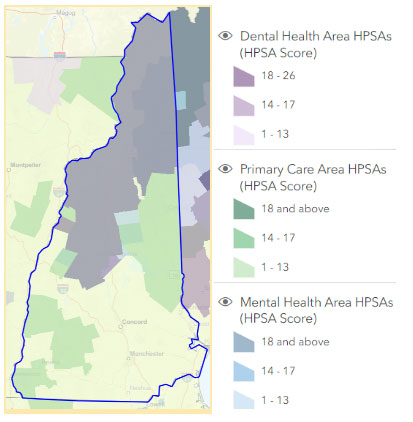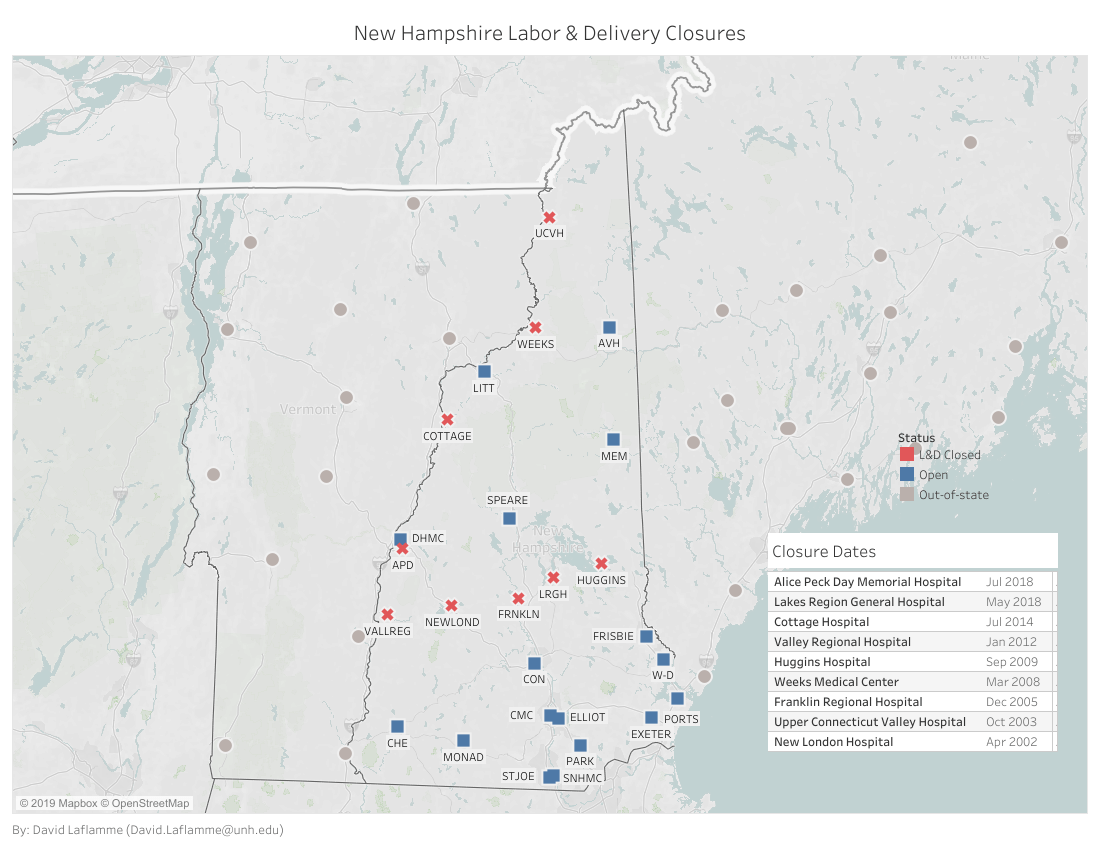Health Status and Outcomes
The Health Status and Outcomes section of the State Health Assessment describes the physical and mental health and healthcare experience of people in NH. The key factors in this section selected to demonstrate the health status and outcomes of NH are:
Below, we present key data points within the factor areas that illustrate what Health Status and Outcomes looks like in our state. We also highlight data points for communities whose experience is very different than what the state level data implies. Whenever possible, we have included data that is easily accessed in the NH Department of Health and Human Services Data Portal’s Social Determinants of Health dashboard. We have provided links to data that is not available on the NH DHHS Data Portal.
Key Findings
Overall, New Hampshire ranks better than other states in the U.S. in many of the factors that are typically measured to assess the health of the population. In the 2021 America’s Health Rankings, the state ranked 4th in the Behaviors Factors (including nutrition and physical activity, sexual health, sleep health, and tobacco use). It also ranked 6th in Clinical Care Factors (including access to care, preventive clinical services, and quality of care), and 7th in Health Outcomes Factors (including behavioral and physical health and mortality). As with most summary measures at the state level, when viewed at demographic, geographic, and cultural-based community levels, outcomes differ from the state total.
What does Health Status and Outcomes look like in NH?
HEALTHY LIVING
Statewide data depicts a positive picture of healthy living by NH residents. While the state ranks better than the U.S. many areas, the population rates for some of these factors are higher in some communities than others, and opportunities for improvement exist across the state.
Healthy Weight and Active Living
|
|
|
|
|
|
Substance Misuse
| Youth Tobacco, E-cigarettes, and Vaping | |
|
|
|
|
| Adult Tobacco | |
|
|
| Alcohol Misuse | |
|
|
| Opioid Use and Treatment | |
|
|
HEALTH OUTCOMES
As is the case with the Healthy Living metrics, NH ranks well in factors related to physical health, premature death, and birthweight in 2022. Morbidity and mortality differences vary across groups, however.
Chronic Condition Burden
| Asthma Prevalence | |
|
|
| Cancer (Age-adjusted rates per 100,000) | |
|
|
| Adults with Diabetes and Heart Disease | |
|
|
|
Mental Health Burden
|
|
|
Life Expectancy and Leading Causes of Death
|
COVID-19
|
|
 During the COVID-19 pandemic, the U.S. Census Bureau Household Pulse Survey measured a number of COVID-related impacts. As of May 2020, 29% of NH adults reported experiencing symptoms of anxiety or depression, 9% were uninsured, and 14.5% delayed getting medical care over the four weeks prior (for something other than coronavirus) due to the pandemic. Additionally, a survey out of the UNH Institute for Health Policy and Practice during April of 2020 found that 37% of respondents moved a medical appointment to telehealth and 17% moved a behavioral health appointment to telehealth due to COVID-19.
During the COVID-19 pandemic, the U.S. Census Bureau Household Pulse Survey measured a number of COVID-related impacts. As of May 2020, 29% of NH adults reported experiencing symptoms of anxiety or depression, 9% were uninsured, and 14.5% delayed getting medical care over the four weeks prior (for something other than coronavirus) due to the pandemic. Additionally, a survey out of the UNH Institute for Health Policy and Practice during April of 2020 found that 37% of respondents moved a medical appointment to telehealth and 17% moved a behavioral health appointment to telehealth due to COVID-19.
ACCESS AND UTILIZATION
While NH ranks better than the U.S. in all County Health Rankings clinical care measures, access, utilization, and affordability of healthcare are inconsistent across the state.
Being able to find a provider when medical services are needed is important to staying healthy, Much of the northern part of NH is designated as a medically underserved area, according to Health Resources and Services Administration (HRSA). This means that there are not enough health care providers or resources to meet the needs of the population. Similarly, much of the northern part of NH is consistently designated as a “Health Professional Shortage Area” for primary care, dental, and mental health services. The HPSA designation for primary care also expands into the central and western parts of the state.
Heath care providers, per 100,000 population (2021):
Primary care providers
Mental health providers
Dentists


Fully accessible health care is difficult to find
“I finally found a therapist who knows ASL but I had extremely limited choices and it took me like two years fighting with my insurance co to get one who was out of network because none were available in network. I need a hearing aid and my insurance doesn’t cover it because I am a NH resident but work in MA. [It’s] hard for me to communicate my needs as a deaf person because the hearing world doesn’t understand what we need.” – 2021 Community Survey respondent
Of particular note is the sharply decreased number of labor and delivery units providing critical prenatal and postpartum care to pregnant people and their infants. A 2021 Urban Institute report summarized that nine of NH’s 16 labor and delivery units closed since 2000, and the median drive time to the nearest maternity care provider more than doubled from 18 minutes to 39 minutes. This same research showed that the further away a pregnant person lived from their maternity care provider, the more likely they were to have less prenatal care, or experience an unplanned home or en route birth – two indicators associated with poorer outcomes.

- Insured through employer 55%
- Medicare 15%
- Medicaid 10%
- Uninsured 6%
Commercial insurance (2019)
- No encounters 33%
- 1 encounter 23%
- 2-4 encounters 33%
- 5+ encounters 10%
In Cheshire county, almost half (45%) of residents had NO primary care visits, but in Rockingham County, more than 70% had at least one primary care visit.
Medicaid (2019-2020)
- No encounters 46%
- 1 encounter 19%
- 2-4 encounters 25%
- 5+ encounters 10%
In Coos County, 67% of residents covered by Medicaid had NO primary care visits, compared to Cheshire County Medicaid recipients, where only 38% had no visits.
Medicare (2018-2019)
- No encounters 53%
- 1 encounter 11%
- 2-4 encounters 22%
- 5+ encounters 14%
In Cheshire County in 2018-2019, 86% of Medicare recipients had NO primary care visits, compared to Rockingham County’s only 29% of Medicare recipients having no visit during the year.
- Commercial insurance (2019) 15%
- Medicaid (2019-2020) 18%
- Medicare (2018-2019) 30%
%
All adults (18+)
%
Age 18-25
Cost
